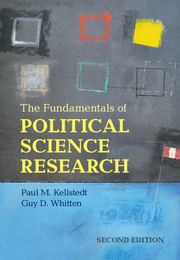Book contents
- Frontmatter
- Contents
- List of Figures
- List of Tables
- Preface to the Second Edition
- Acknowledgments to the Second Edition
- Acknowledgments to the First Edition
- 1 The Scientific Study of Politics
- 2 The Art of Theory Building
- 3 Evaluating Causal Relationships
- 4 Research Design
- 5 Getting to Know Your Data: Evaluating Measurement and Variations
- 6 Probability and Statistical Inference
- 7 Bivariate Hypothesis Testing
- 8 Bivariate Regression Models
- 9 Multiple Regression: The Basics
- 10 Multiple Regression Model Specification
- 11 Limited Dependent Variables and Time-Series Data
- 12 Putting It All Together to Produce Effective Research
- Appendix A Critical Values of Chi-Square
- Appendix B Critical Values of t
- Appendix C The Λ Link Function for Binomial Logit Models
- Appendix D The Φ Link Function for Binomial Probit Models
- Bibliography
- Index
Preface to the Second Edition
- Frontmatter
- Contents
- List of Figures
- List of Tables
- Preface to the Second Edition
- Acknowledgments to the Second Edition
- Acknowledgments to the First Edition
- 1 The Scientific Study of Politics
- 2 The Art of Theory Building
- 3 Evaluating Causal Relationships
- 4 Research Design
- 5 Getting to Know Your Data: Evaluating Measurement and Variations
- 6 Probability and Statistical Inference
- 7 Bivariate Hypothesis Testing
- 8 Bivariate Regression Models
- 9 Multiple Regression: The Basics
- 10 Multiple Regression Model Specification
- 11 Limited Dependent Variables and Time-Series Data
- 12 Putting It All Together to Produce Effective Research
- Appendix A Critical Values of Chi-Square
- Appendix B Critical Values of t
- Appendix C The Λ Link Function for Binomial Logit Models
- Appendix D The Φ Link Function for Binomial Probit Models
- Bibliography
- Index
Summary
We received a wealth of helpful feedback on the first edition of this book. In crafting a new edition, our challenge was to try to produce a book that incorporated as much of this feedback as possible, coupled with our ideas for changes, while at the same time keeping the book at roughly the same length. Our general goals in the second edition were to produce more exercises at the end of the chapters, to make our explanations as clear and accessible as possible, and to incorporate more examples from published research.
We added substantially to the exercises available at the end of each chapter. The second edition contains 101 exercises, compared to the 59 in the first edition. In addition, we also have added substantially to both the general and instructor-only sections of the webpage for our book (http://www.cambridge.org/fpsr). The general section now contains the guides for conducting the analyses discussed in the book for the SPSS, Stata, and R statistical programs, as well as many more data sets available in formats compatible with all three programs. The instructor- only section contains several additional resources, including PowerPoint and TEX/Beamer slides for each chapter, a test-bank, and answer keys for the exercises.
In the new edition, at the end of each chapter we have added short working definitions for each bolded term introduced in that chapter. The trade-off here is one between making the materials in the book more accessible versus running the risk of offering over-simplified definitions that might mislead students into thinking that they can master the book's materials by simply memorizing these definitions.
Information
- Type
- Chapter
- Information
- The Fundamentals of Political Science Research , pp. xix - xxPublisher: Cambridge University PressPrint publication year: 2013
